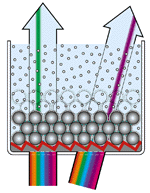Liquid Crystal Communication
 The Information Age rides on beams of carefully controlled light. Because lasers form the arteries of modern communications networks, dexterous manipulation of light underpins the two definitive technologies of our times: telecommunications and the Internet. Now researchers at Harvard University have developed a new way of steering and manipulating light beams. Using droplets of liquid crystals--the same substance in laptop displays--the scientists can make a pane of glass that quickly switches from transparent to diffracting and back again. When the pane is transparent a laser beam passes straight through, but when the pane is diffracting, it splits the beam, bending it in several new directions.
The Information Age rides on beams of carefully controlled light. Because lasers form the arteries of modern communications networks, dexterous manipulation of light underpins the two definitive technologies of our times: telecommunications and the Internet. Now researchers at Harvard University have developed a new way of steering and manipulating light beams. Using droplets of liquid crystals--the same substance in laptop displays--the scientists can make a pane of glass that quickly switches from transparent to diffracting and back again. When the pane is transparent a laser beam passes straight through, but when the pane is diffracting, it splits the beam, bending it in several new directions.
The change is triggered by applying an electric field, so the pane could easily be controlled by the electric signals of a computer, offering a powerful new way to steer beams of light. Beyond telecommunications, one could imagine this light-steering ability being useful in astronomy. For example, these liquid-crystal panes could be used in reverse to combine (rather than split) beams of light from multiple telescopes. Combining light from many telescopes, a technique called interferometery, is a good way to search for distant planets around other stars. Another application: a liquid crystal pane held in front of the mirror of a telescope could be used to 'unwrinkle' light that has passed through Earth's turbulent atmosphere. Such adaptive optics telescopes could gain a crystal-clear view of the heavens from Earth's surface.
Liquid crystals are a class of liquids whose molecules are more orderly than molecules in regular fluids. Because of this orderliness, when these liquids interact with light, they can affect the light like crystals do. Making droplets of liquid crystals is nothing new; the basic technology has been around since the mid-1980s. Today you can find such droplets in the window-walls of some executives' offices. With the flip of a switch, the office's transparent windows magically change to opaque walls somewhat like frosted glass.
About the Author
NASA Marshall Space Flight Center
 The George C. Marshall Space Flight Center, located in Huntsville, Alabama, is the U.S. government's civilian rocketry and spacecraft propulsion research center. As the largest NASA center, MSFC's first mission was developing the Saturn launch vehicles for the Apollo program.
The George C. Marshall Space Flight Center, located in Huntsville, Alabama, is the U.S. government's civilian rocketry and spacecraft propulsion research center. As the largest NASA center, MSFC's first mission was developing the Saturn launch vehicles for the Apollo program.


